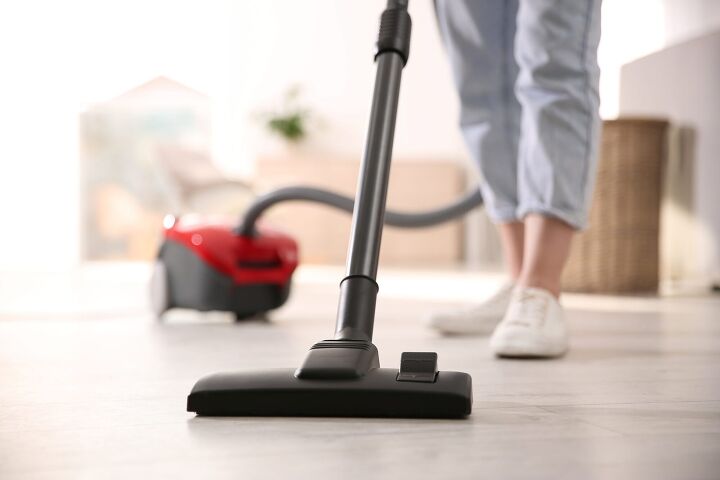My Shark Vacuum Won't Turn On

Has this happened to you? You drop the coffee grounds all over the floor when trying to make your morning cup of Joe. No problem, you think, you’ll just grab your trusty Shark vacuum. The only problem, it won’t turn on, and you’re forced to reach for the broom and dustpan.
If your Shark vacuum doesn’t turn on, first check the obvious. Make sure your vacuum is plugged in properly. For cordless vacuums, ensure the batteries are charged and in good condition.
Clean dirty and clogged filters and vacuum hoses. If your vacuum still won’t start, it could be a bad motor, faulty power switch, or damaged power cord.
If you can’t get your Shark vacuum to start, it can really put a dent in your cleaning routine. But don’t assume your vacuum’s ready for the trash heap. It could be a simple fix, and you’ll be back to cleaning up messes in no time. (Lucky you.)
Why Does My Shark Vacuum Have No Power?
If your Shark vacuum is getting no power at all, start with the simplest solutions first. For a corded vacuum, make sure you plug it in correctly. It could be that the plug isn’t in all the way.
In some cases, the prongs could be bent, preventing the plug from going all the way into the outlet.
It’s also worth checking the integrity of the outlet. Try plugging your vacuum into a different outlet to see if it makes a difference. If it works, you know the outlet was the problem.
If you’re using a cordless robot Shark vacuum, when’s the last time you charged it? You might simply need to charge your vacuum, and you’ll be back in business.
But let’s face it. If you’re here, you’ve likely already checked the obvious solutions, and they didn’t work. So, let’s look at other common reasons your Shark vacuum won’t turn on.
Common Issues With Shark Vacuum Not Turning On
Here are some of the most common reasons your Shark vacuum won’t turn on and potential solutions.
1. Damaged Power Cord
If the vacuum is securely plugged in and the outlet is getting power, it could be the cord. Power cords don’t last forever, and your vacuum cord can wear out over time.
This issue can be especially true if you aren’t cautious with the cord when you vacuum. For example, you consistently roll the vacuum over the cord, yank it, etc.
When you vacuum, take care not to roll over the cord, pull it, or put excessive stress on it. To check the cord, unplug the vacuum first. Look closely at the cord for any visible cuts, exposed wires, or other signs of wear.
If you notice any of the above, the issue could be with the cord. Contact a specialist about replacing the cord or see if you have an active warranty on your Shark vacuum.
Avoid replacing the cord yourself unless you’re very experienced with electrical work. Trying to repair it yourself could potentially void any warranty that is in place.
2. Clogged Or Dirty Vacuum Filter
It’s essential to regularly clean your vacuum filters for optimal performance. If the filter becomes overly dirty or clogged, it reduces suction, and your vacuum could stop working completely.
Consult your Shark vacuum’s manual or look on the Shark website to find the filter information for your particular model. Most models feature foam filters, a felt filter, and a HEPA filter. Before you clean them, ensure your vacuum comes with washable filters.
Remove any loose, visible dirt, then rinse the filters in cool water. Keep rinsing until the water runs clear. Do not use any type of soap or detergent on the filters.
Gently squeeze out excess water or press the filters with a towel. Let the filters dry thoroughly before putting them back into the vacuum. How often you clean the filters varies by model.
Depending on the frequency of use and the model, you should clean felt and foam filters every one to three months. Clean HEPA filters one to three times a year. Check with your specific Shark vacuum to determine the best filter-cleaning schedule for your device.
If filters look worn, it’s best to replace them. You can find replacement filters on Shark’s website or on Amazon.
3. Failing Battery
If you have a Shark robot vacuum, it might not turn on because the battery isn’t charged. Make sure you charge the battery fully, then try to power on the vacuum again. (It’s good practice to recharge your vacuum between every cleaning session.)
The typical battery life for a Shark vacuum is two years. If the battery doesn’t charge even though the charger light is on, it could be dirty. Ensure the contacts on the battery and charger are clean and unobstructed.
Unplug the charger, wipe the contacts on the battery and charger with a microfiber cloth, and try again. If it still doesn’t charge, but the charger light is on, you might need a replacement battery.
If the charger light is not going on, the charger could be the problem. Contact Shark about a replacement.
Once again, check with Shark about any warranties that might be in place for your charger or battery. Many Shark battery devices feature a two-year limited battery warranty.
4. Faulty Vacuum Power Switch
If the lights on your Shark vacuum turn on, but it just doesn’t start, it could be a bad power switch. Some possibilities are the power switch is stuck and not going on fully, or it’s faulty. Contact Shark to find out if a replacement switch is a possibility.
However, if the switch is in the on position and working normally, but your vacuum doesn’t start, it could be a bad motor.
5. Damaged Motor
Before assuming the worst, attempt to reset the motor. This step assumes you’ve already checked for clogged and dirty filters/hoses and cleaned or replaced them accordingly. If the Shark vacuum overheated, it could have tripped the motor’s thermostat.
To reset the thermostat in the motor, switch the power button to the off position. Unplug the vacuum to avoid any potential electrical shock.
Allow the vacuum to cool for at least 45 minutes. Plug the vacuum back in, turn it on, and see if it starts. If it still doesn’t work, the motor could be completely broken. As durable as Shark vacuums are, nothing lasts forever, and motors wear down.
If you use your vacuum frequently, your motor might wear out sooner than expected. If you’re handy with small appliances, you could remove the motor and inspect it for obvious issues. (Keep in mind this could void any warranty on the vacuum.)
Your other options are consulting a vacuum repair specialist or calling Shark’s Customer Service at 1-877-581-7375. If they determine you need to replace the motor, it is probably more cost-effective to get a new vacuum. By the time you buy a new motor and pay for repairs, it will likely cost you more.
6. Tripped Circuit Breaker
If your vacuum seems perfectly fine, has clean filters, and everything looks good, the problem could be a tripped breaker. Vacuums can pull a large amount of electricity when you first power them on, blowing a fuse or tripping a circuit breaker.
Check the outlet you’re using for a reset button. Press it to see if it solves the issue. If the outlet doesn’t have a reset button, go to your breaker panel and flip the appropriate breaker. If you have blown a fuse, you’ll need to replace it.
7. Is There A Reset Button On My Shark Vacuum?
Various Shark vacuums have a reset button or procedures to follow to reset the device. However, this varies based on the model, so it’s best to consult the manufacturer’s website or your vacuum’s manual.
Is It Time To Replace Your Shark Vacuum?
According to Consumer Reports and their reliability survey, the average lifespan of a vacuum is eight years. Of course, this timeline varies based on the brand. Shark vacuums have reliable reputations, and depending on how you take care of it and how often you use it, your Shark could last you several years longer.
The opposite is also true. If you use it every day and don’t take the best care of it, your Shark vacuum might wear out sooner rather than later.
The general rule of thumb when it comes to replacing appliances is to look at the cost of repairs compared to the cost of replacing. If it will cost you more than 50% of the price of a new vacuum to repair your current one, and you’ve already had it for a few years, you might just want to replace it.
If it’s brand new, then you likely can utilize the warranty. If your vacuum is a few years old, but repairs will cost less than 50% of the replacement price, it could be worth having a professional fix it.
Tips For Keeping Your Vacuum Running
Your vacuum is the appliance you want to suck. So when you turn it on, and it doesn’t do anything, it can be frustrating. Follow these simple maintenance tips to get the most out of your Shark vacuum.
- Clean out and dump the dust and debris container after every use.
- Regularly clean the filters and replace them as needed.
- Check the motorized brush and wheels weekly for strings, tangled hair, and other possible obstructions.
- Inspect any hoses on your vacuum every few weeks for clogs or blockages.
- Don’t vacuum over the power cord or yank it out of the outlet.
- Keep the contacts on the battery and charger of robot vacuums clean and clear.
Help! My Vacuum Doesn’t Suck!
Before you call a repair pro or buy a new vacuum, check the plug and power switch. Sometimes, it might not be plugged in all the way, or the power switch isn’t entirely in the proper position.
Another possibility is the outlet you’re using isn’t getting power, or the vacuum tripped a circuit breaker.
But if these more straightforward solutions aren’t the case, dig deeper. Make sure the cord is in good shape, or the battery is charged, depending on your vacuum’s power source.
If all looks good, ensure the charger is working properly, and the contacts on the charger and battery are clean.
You might need a new battery. Or, in more serious situations, there could be a faulty motor. Before you spend money on replacing your vacuum’s motor, do the math. It’s probably cheaper to get a new vacuum.
After a little troubleshooting, you’ll know if you need the help of a pro. You can call Shark’s customer service to see if you have any active warranties that you can use. They can steer you in the right direction, and you’ll be back cleaning again in no time.
Related Guides:

Stacy Randall is a wife, mother, and freelance writer from NOLA that has always had a love for DIY projects, home organization, and making spaces beautiful. Together with her husband, she has been spending the last several years lovingly renovating her grandparent's former home, making it their own and learning a lot about life along the way.
More by Stacy Randall























![Standard Dining Room Table Dimensions [for 4, 6, 8, 10 and 12 People]](https://cdn-fastly.upgradedhome.com/media/2023/07/31/9074335/standard-dining-room-table-dimensions-for-4-6-8-10-and-12-people.jpg?size=350x220)



